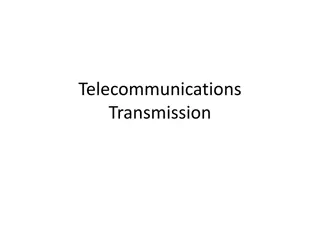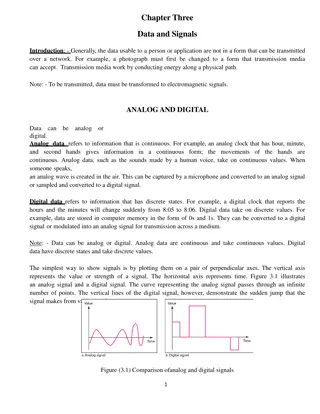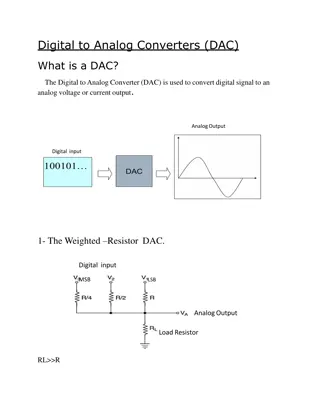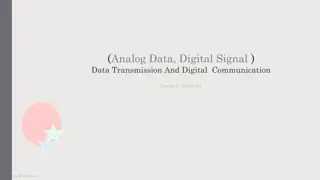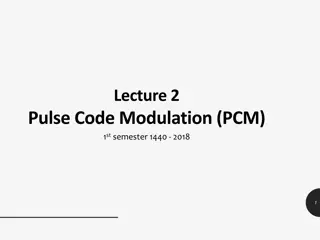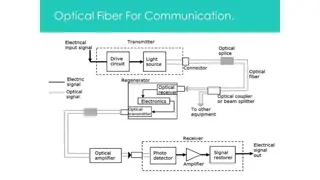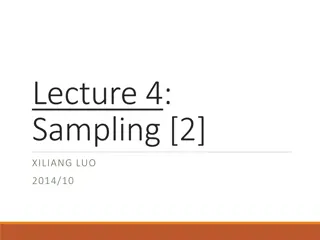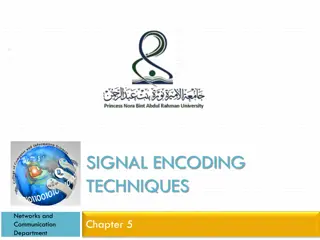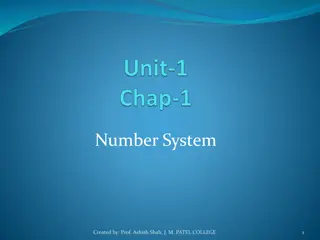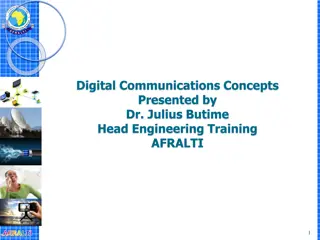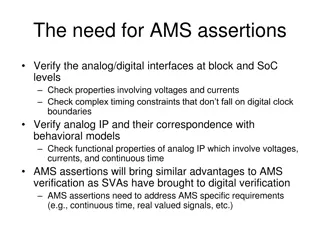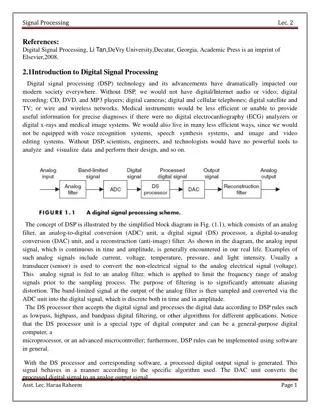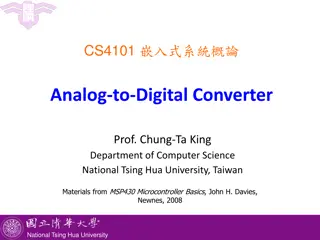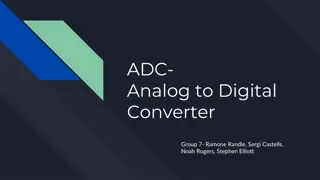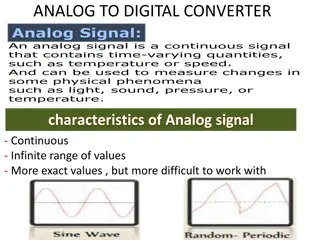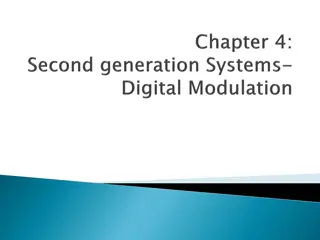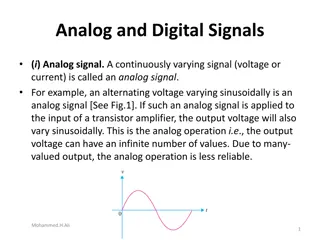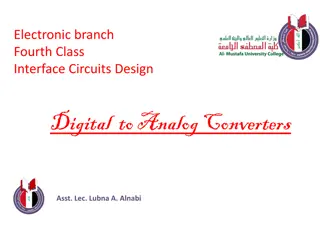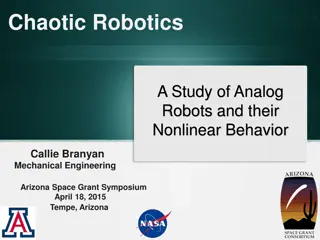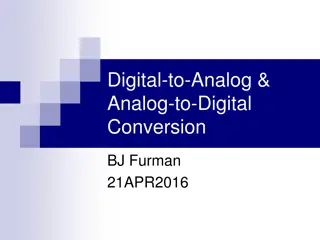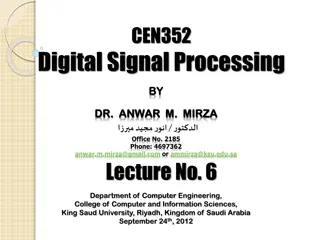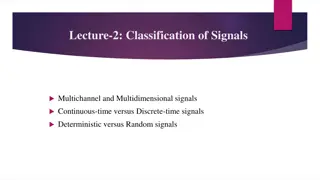Analog Computer Simulation of Mechanical Oscillations with Damping
Explore the analog computer simulation of mechanical oscillations with and without damping in a physics-themed project. Students can visualize classical physics concepts through hands-on analog circuit design, modeling spring-mass systems and RLC circuits. The project involves constructing a breadbo
1 views • 11 slides
Telecommunications Transmission Systems
Transmission systems in telecommunications provide circuits between network nodes using channels for bidirectional communication. Channels can range from simple audio circuits to complex satellite systems. Signals can be analog or digital, each with its unique characteristics. Bandwidth is crucial f
0 views • 32 slides
Data and Signals in Networks
Data transmission involves converting information into electromagnetic signals for communication. Analog data is continuous, like a clock's hands, while digital data is discrete, like binary code in computer memory. Signals can be analog or digital, periodic or non-periodic, with characteristics lik
1 views • 17 slides
Interfacing with Analog Signals in Embedded Systems
Exploring the conversion of analog signals from the physical world into electrical signals using transducers in embedded systems. Learn about going from analog to digital representation, choosing sample rates, the Shannon-Nyquist sampling theorem, importance of anti-aliasing filters, and the necessi
1 views • 18 slides
Digital to Analog Converters (DAC) and Their Applications
Digital to Analog Converters (DAC) are essential components used to convert digital signals into analog voltage or current outputs. This article explains the working principle of DACs, provides examples of different types such as Weighted Resistor DAC, R-2R Ladder DAC, Feedback Amplifier DAC, and Si
0 views • 9 slides
Analog Data and Digital Signal Transmission
This lecture delves into the concepts of analog data, digital signals, and the processes involved in data transmission and digital communication. It covers topics such as Pulse Amplitude Modulation (PAM), Analog-to-Digital Conversion, and Sampling. The conversion of analog signals to digital signals
1 views • 34 slides
Pulse Code Modulation (PCM) in Analog to Digital Conversion
This content delves into the realm of Pulse Code Modulation (PCM), outlining its significance in converting analog data to digital signals. It covers the process of Analog to Digital Conversion, emphasizing the advantages of digitizing analog signals for improved quality and reduced noise. The steps
1 views • 14 slides
Overview of Point-to-Point Fiber Optic Communication System
Point-to-point fiber optic communication systems involve converting voice signals from a microphone into digital signals using a coder, transmitting light signals through a semiconductor diode laser over optical fibers, and decoding the signals back to analog for sound production. The system offers
0 views • 11 slides
Sampling and Signal Processing Fundamentals
Sampling plays a crucial role in converting continuous-time signals into discrete-time signals for processing. This lecture covers periodic sampling, ideal sampling, Fourier transforms, Nyquist-Shannon sampling, and the processing of band-limited signals. It delves into the relationship between peri
1 views • 60 slides
Signal Encoding Techniques in Networks and Communication
This chapter delves into signal encoding techniques used in digital data transmission, covering key concepts such as encoding schemes like NRZ-L and NRZI, multilevel binary encoding, and biphase encoding. It explores the fundamentals of digital signaling, modulation techniques, and the relationship
4 views • 34 slides
Analog and Digital Systems in Telecommunications
Analog systems involve altering a base carrier's frequency to encode information, while digital systems represent data as strings of 0s and 1s. Prof. Ashish Shah explains the concepts in a clear and informative manner, highlighting the differences between analog and digital technologies in telecommu
1 views • 33 slides
Analog Accelerator: Memristor Basics and ISAAC Accelerator
Explore the world of analog acceleration with topics covering memristor basics and the ISAAC accelerator. From understanding noisy analog phenomena to leveraging wires as ALUs, delve into crossbars for vector-matrix multiplication and the challenges of high ADC/DAC area/energy. Discover solutions li
2 views • 23 slides
Overview of Communication Systems: Signal vs. Noise
Communication systems involve a battle between signal and noise/distortion, with information represented in analog or digital form. Analog signals include speech, music, and temperature readings, while digital signals can represent text and computer data. The history of analog and digital messages,
1 views • 17 slides
Advanced Configurable Analog I/O Modules for Automation Systems
Explore a range of onboard analog I/O modules including BX10, BX18, and BX36 series, each offering high-speed discrete inputs and outputs along with analog input and output options. These modules are fully configurable with flexible voltage and current ranges. Additionally, learn about the new memor
0 views • 7 slides
Analog and Digital Communications Concepts
Exploring the differences between analogue and digital signals, this content presents a comprehensive overview. It covers the definitions of analog, the prevalence of analog signals in our surroundings, and the advantages of digital communication such as error correction, encryption, and data proces
0 views • 13 slides
Advancing AMS Assertions for Analog/Digital Interface Verification
AMS assertions play a crucial role in verifying analog/digital interfaces, checking properties related to voltages, currents, and complex timing constraints. They bring advantages similar to SVAs in digital verification, addressing specific AMS requirements. Examples showcase comparisons of voltage/
0 views • 11 slides
Digital Signal Processing in Modern Society
Digital Signal Processing (DSP) technology has revolutionized modern society by enabling advancements in areas such as audio, video, communication, medical diagnostics, image processing, and data analysis. This technology involves converting analog signals to digital, applying digital algorithms for
0 views • 4 slides
Digital to Analog Converters
Digital-to-Analog Converters (DACs) play a crucial role in converting digital data to analog signals. Explore DAC applications, performance parameters, potential errors like quantization error and non-linearity, and DAC architectures such as R-2-R ladder and Switched Capacitors. Understand the impor
0 views • 26 slides
Applications of Spectrum Analyzer in Amateur Radio
The spectrum analyzer is a crucial tool in amateur radio for analyzing signals in both time and frequency domains. It enables representation of various signals like audio, ultrasonic, and RF. By utilizing techniques such as the Fourier transform, signals can be converted from time to frequency domai
0 views • 24 slides
Analog-to-Digital Converter
This content delves into the fundamental concepts and practical applications of analog-to-digital conversion (ADC). Learn how ADC enables the transformation of analog signals into digital data for processing, explore the importance of sampling intervals, and grasp the significance of digital signal
0 views • 43 slides
Digital Transmission and Analog to Digital Conversion Overview
This content covers concepts related to data transmission, digital communication, analog-to-digital conversion, and more. Explore topics such as Pulse Code Modulation, sampling, quantizing, encoding, Nyquist Theorem, sampling methods, and the significance of digital signals over analog. Gain insight
0 views • 34 slides
Signals and Terminal I/O
In the world of programming, signals play a crucial role in inter-process communication and controlling program behavior. This content delves into how signals inform processes of events, the common signals used, handling signals, catching signals, ANSI C signal functions, and managing signal sets in
0 views • 16 slides
Introduction to PLC Analog Signal Input Modules
In industrial automation, analog signals play a crucial role in transmitting measuring units. The Delta DVP-04AD-S module converts external analog input signals into 14-bit digital values for PLC operations. With voltage input ranging from -10 to 10V and current input from -20 to 20mA, this module e
0 views • 7 slides
Understanding Analog to Digital Conversion (ADC) Process
Learn about Analog to Digital Conversion (ADC), the differences between analog and digital signals, the need for ADC in computing, real-world examples, common errors in ADC conversion, the physics behind ADC, and its relevance in Arduino projects. Gain insights into how ADC works, its applications w
0 views • 9 slides
ECE382 Lesson 35: Analog to Digital Conversion and ADC Process Overview
Explore the fundamentals of Analog to Digital Conversion (ADC) in ECE382 Lesson 35, understanding the process of sampling, quantizing, and encoding signals. Witness how digital representation deviates from analog, with insights on resolution, sampling, and more. Delve into ADC example code, learning
0 views • 24 slides
Understanding Analog to Digital Conversion Process
Learn about the differences between analog and digital signals, the advantages and disadvantages of each, and the process of converting analog signals into digital using sampling. Explore how digital signals are discrete and easier to work with, while analog signals offer infinite data and higher de
0 views • 6 slides
Understanding Digital-to-Analog Conversion and Its Applications
Learn about Digital-to-Analog Converters (DAC) and their significance in converting digital signals to analog signals for various devices like portable media players, TVs, and more. Explore circuit diagrams and examples of DAC implementations in electronic devices.
0 views • 11 slides
Understanding Information Sources, Signals, and Data Communication
Explore the intersection of physics, mathematics, and electrical engineering in data communication, analyzing information sources, analog vs. digital signals, sine waves, and composite signals like Fourier transform. Discover the essentials of effective communication and signal characteristics.
0 views • 32 slides
Band Limited Signals and Sampling Theorem Overview
Explore the concept of band-limited signals and the sampling theorem in the context of time-limited and narrowband signals. Understand the characteristics and examples of time-limited signals, as well as the definition and properties of band-limited signals. Dive into the fundamentals of signal proc
0 views • 23 slides
Understanding Analog to Digital Conversion in Signal Processing
Dive into the concept of analog to digital conversion in signal processing, covering topics such as PCM, Nyquist law, quantization, companding, digital encoding, and data rates. Learn how analog signals are converted to digital pulses and the techniques involved in signal reconstruction. Explore the
0 views • 27 slides
Digital vs Analog Signal Conversion: Sampling, Quantizing, Coding
Discover the process of converting analog signals to digital using techniques like sampling, quantizing, and coding. Learn how sampling ensures accurate representation of analog signals in the digital realm, adhering to the sampling theorem for optimal signal reconstruction. Explore various sampling
0 views • 26 slides
Understanding Analog and Digital Signals in Electronics
Explore the difference between analog and digital signals, their reliability, and the concept of binary numbering systems. Discover how electronic circuits and transistors handle these signals, and delve into the fundamentals of counting in decimal and binary systems.
0 views • 34 slides
Understanding Digital to Analog Converters in Electronic Circuits
Learn about Digital to Analog Converters (DACs) and how they convert digital signals to analog voltage or current outputs. Derive equations, analyze binary-weighted resistor circuits, and calculate Vout for different scenarios using examples.
0 views • 16 slides
Understanding Analog to Digital Converter Basics
Explore the fundamentals of Analog to Digital Converters (ADC) in ECE academic labs with slides by Zachary Chan. Learn about ADC, sampling rate, Nyquist rate, Nyquist frequency, resolution, and more key concepts essential for converting analog signals to digital in microcontrollers.
1 views • 13 slides
Understanding Analog to Digital Signal Conversion in Communication
Explore the process of converting analog signals to digital signals in the realm of communication technology. Discover the importance of digital signals over analog, the sampling process, and the sampling theorem. Learn about sampling, quantizing, coding, and the reconstruction of signals in this in
0 views • 26 slides
Exploring Analog Robotics and Nonlinear Behavior in Chaotic Robotics Study
Dive into the world of analog robotics and nonlinear behavior with a study on chaotic robotics by Callie Branyan. The research aims to develop an analog circuit showcasing nonlinear behavior for enhanced performance over digital counterparts and creating more resilient robots for autonomous explorat
0 views • 14 slides
Understanding Digital-to-Analog and Analog-to-Digital Conversion Techniques
Explore the principles of Digital-to-Analog and Analog-to-Digital Conversion through DACs, ADCs, R-2R Ladder DAC, and Successive Approximation ADC. Learn about their applications, resolutions, and working mechanisms in electronic systems.
0 views • 10 slides
Understanding Analog-to-Digital Conversion in Microcontrollers
Learn about the process of analog-to-digital conversion (ADC) in microcontrollers, and how it helps in transforming analog signals into digital data. Explore the principles, types of ADC, digitalization, signal processing, and more.
0 views • 22 slides
Digital Signal Processing and Quantization: Understanding Analog Signals
Explore the concept of quantization in digital signal processing through examples of analog signals being converted into discrete-time signals, illustrating the effects of truncation and rounding on the quantization process.
0 views • 13 slides
Understanding Signal Classification: Multichannel, Continuous Signals & More
Explore the classification of signals, including multichannel and multidimensional signals, continuous-time versus discrete-time signals, deterministic versus random signals, periodic and non-periodic signals, and the concepts of discrete signals and analog signal sampling.
0 views • 10 slides

